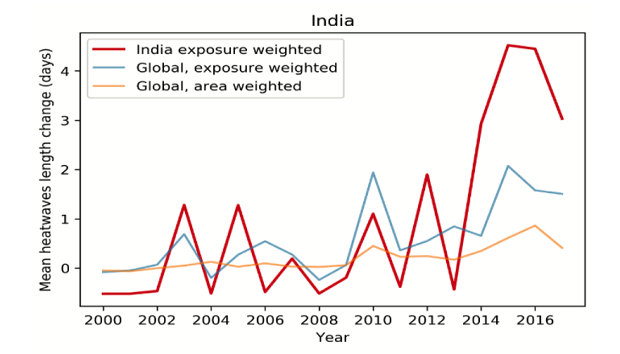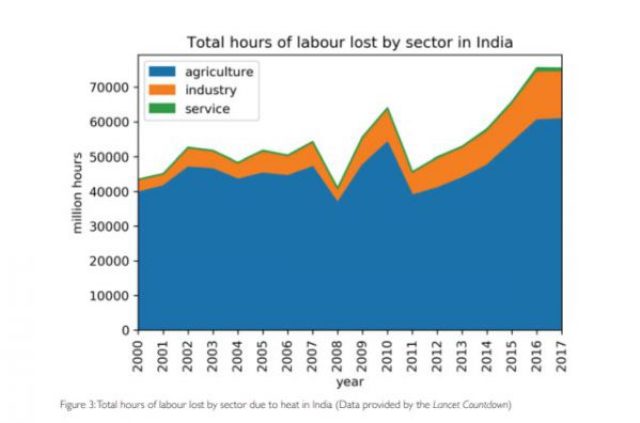What is the issue?
- The Lancet Countdown report on health and climate change was released recently.
- Increased exposure to heatwaves needs a policy response, nationally and globally.
What are the highlights of the report?
- It is a global report prepared by 27 leading academic institutions, the United Nations and inter-governmental agencies.
- Globally, vulnerability to extremes of heat has steadily risen since 1990 in every region.
- Nearly 157 million more people are exposed to heatwaves in 2017 as compared to the year 2000.
- The average person experienced an additional 1.4 days of heatwaves per year over the same period.
- India - Between 1901 and 2007, India's mean temperature increased by more than 0.5 degree Celsius.
- India saw an increase of 40 million in the number of people exposed to heatwaves from 2012 to 2016.
- Average temperatures in India are projected to rise alarmingly.
- The world is bracing for an increase of around 2 degrees Celsius over the 21st century.
- The northern, central and western India may witness further increase averaging 2.2 to 5.5 degrees by the end of the 21st century.

What are the impacts?
- Health - Heatwaves are associated with increased rates of heat stress and heat stroke, exacerbation of heart failure and acute kidney injury from dehydration.
- Children, the elderly and those with pre-existing morbidities are particularly vulnerable.
- The report warns that rising temperatures will enable the dengue, virus, and malaria to spread farther and faster; true of some other infections as well.
- Low and middle-income countries, India included, are likely to be worst affected by climate change.
- This is exacerbated by weaker health systems and poorer infrastructure.
- This may, additionally, lead to further widening of existing health and economic inequities.
- Economy - The report shows that 153 billion hours of labour were lost globally in 2017 due to heat.
- This is an increase of 62 billion hours relative to year 2000.
- The impacts vary with different sectors, with agriculture being most vulnerable as compared to the industrial and services sector.
- Between 2000 and 2017, labour hours lost in agriculture rose from about 40,000 million hours in 2000 to about 60,000 million hours in 2017.
- Notably, India's agriculture economy makes up 18% of the country's GDP and employs nearly half the population.
- So the above translates into substantial climate-related impacts on the country's workforce and economy.
- It has worrying implications for rural employment and well-being of the farming-dependent population.
- Overall, India lost nearly 75,000 million hours of labour in 2017, relative to about 43,000 million hours in 2000.

What lies before India?
- The report termed the surge in heatwaves in India as an imminent danger to health.
- It thus called for urgent action to develop and implement local heat action plans.
- Identifying local heat hot spots through appropriate tracking and modelling of meteorological data is crucial to tackle the crisis.
- Infrastructure - Ahmedabad Municipal Corporation (AMC) has adopted a heat action plan.
- It necessitates measures such as building heat shelters, ensuring availability of water and removing neonatal ICU from the top floor of hospitals.
- It has helped bring down the impact of heatwave of vulnerable population.
- Similar action plan should be adopted and developed by other states too.
- Carrying out comprehensive city-level traffic surveys to guide urban infrastructure is also needed.
- Promoting safe walking and cycling to reduce the emission load should be taken up.
- Emission - The lost hours of labour calls for the governments to make efforts to significantly curb greenhouse gas emissions.
- A further reduction in the share of coal in the energy mix must form the cornerstone of national policy.
- This could be through sustained support for renewable energy, particularly solar photovoltaics.
- This must be matched by a shift away from use of fossil fuels for transport, and the induction of more electric vehicles.
- Such a policy would yield the parallel benefit of improving air quality as well.
- Notably, ambient air pollution led to the premature death of an estimated half a million people in India in 2015.
- Climate Plan - India’s approach to climate change adaptation should prepare for catastrophes with a well-considered plan to provide relief and rehabilitation.
- E.g. the strong climate link to the excessive rain in Kerala and Cyclone Gaja in Tamil Nadu
- The importance of funds for adaptation is underscored by Lancet ’s finding that 99% of losses from climate-related events in low-income countries were not insured.
- So a case could be made for climate funds under the Paris Agreement.
- Such a claim has to be supported by a perspective plan that identifies vulnerable regions and communities.
- It should also incorporate transparent systems for funds utilisation.
Source: Economic Times, The Hindu

